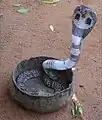The four venomous snake species responsible for causing the greatest number of medically significant human snake bite cases on the Indian subcontinent (majorly in India) are sometimes collectively referred to as the Big Four. They are as follows:[1][2]
- Russell's viper, Daboia russelii
- Common krait, Bungarus caeruleus
- Indian cobra, Naja naja
- Indian saw-scaled viper, Echis carinatus
 Daboia russelii, Russell's viper
Daboia russelii, Russell's viper Bungarus caeruleus, the common krait
Bungarus caeruleus, the common krait Naja naja, the Indian cobra
Naja naja, the Indian cobra_Photographed_By_Shantanu_Kuveskar.jpg.webp) Echis carinatus, the saw-scaled viper
Echis carinatus, the saw-scaled viper.jpg.webp) Snakebites by species in India[3]
Snakebites by species in India[3]
According to a 2020 study that did a comprehensive analysis of snake bites in India, Russell's viper accounted for 43% of the snakebites in India, followed by kraits (18%), cobras (12%), hump nose viper (4%), saw-scaled viper (1.7%), and water snake (0.3%). The rest (21%) were of unidentified species.[3]
 Seasonality of snakebite deaths in India
Seasonality of snakebite deaths in India Snakebite death rates by altitude
Snakebite death rates by altitude
Treatment
A polyvalent serum that effectively neutralizes the venom of the Big Four is widely available in India, and is frequently administered to save lives.
References
- ↑ Mukherjee, Ashis K. (2012). "Green medicine as a harmonizing tool to antivenom therapy for the clinical management of snakebite: The road ahead". Indian J Med Res. 136 (1): 10–12. PMC 3461710. PMID 22885258.
- ↑ Whitaker Z. 1990. Snakeman. Penguin Books Ltd. 192 pp. ISBN 0-14-014308-4.
- 1 2 Suraweera, Wilson; Warrell, David; Whitaker, Romulus; Menon, Geetha; Rodrigues, Rashmi; Fu, Sze Hang; Begum, Rehana; Sati, Prabha; Piyasena, Kapila; Bhatia, Mehak; Brown, Patrick (2020-07-07). "Trends in snakebite deaths in India from 2000 to 2019 in a nationally representative mortality study". eLife. 9: e54076. doi:10.7554/eLife.54076. ISSN 2050-084X. PMC 7340498. PMID 32633232.
This article is issued from Wikipedia. The text is licensed under Creative Commons - Attribution - Sharealike. Additional terms may apply for the media files.